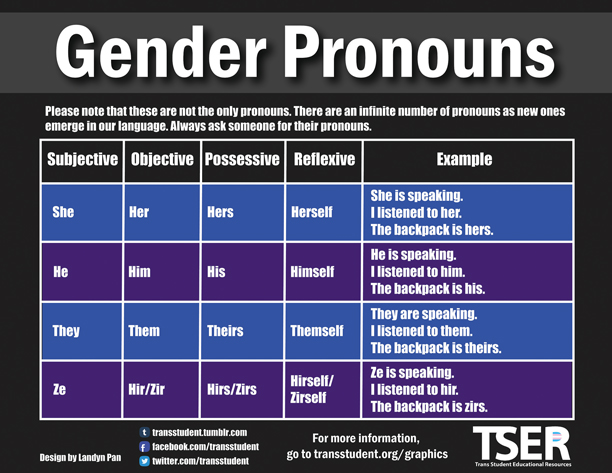
Misgendering a person—such as referring to someone as “sir” or “she” when they are not—is an act of gender violence. It may seem like an innocent mistake, or not a big deal. But for a transgender person, being misgendered cuts to the core of their identity. “That sensation is a potent split-second mixture of anxiety and helplessness and fury and shame and dread and resignation,” writes Joli St. Patrick.1 Samara Ballen explains, “Misgendering someone is… a window into your perception of a person. It’s unconscious honesty that you see a person as nothing different than their birth sex.”2
In the English language, pronouns are used to replace a noun or phrase. Through formal education, we are taught to refer to people in a binary, which assumes that all people use “he” or “she” singular pronouns (“He went to catch the ball” or “She ran to catch the bus”). In reality, there is a broader spectrum of pronouns that people may use. Over the past two decades, for example, using “they” as a singular pronoun has become more common in the transgender community.
Pronouns are not just an elementary grammatical concept. Pronouns are a fundamental element of recognizing and affirming a transgender person’s identity. This article aims to provide more information on transgender identities and offer practical advice to those who want to prevent misgendering and be more inclusive in their language.
TRANSGENDER 101: FUNDAMENTAL TERMINOLOGY
Understanding transgender identities and language is a crucial first step in learning how to use the correct pronouns. In our society, we often conflate sex and gender when they are, in fact, very different. Sex is a label, determined by an observer’s interpretation of a person’s anatomy at birth. Usually, sex is medically defined as male, female, or intersex.3 Gender is more complex and is influenced by social, cultural, and psychological factors. Everyone has a gender identity, which is an internal knowledge of your own gender; this is how you know you are a man, woman, or a different gender.4
Given all these terms, “transgender” describes a person whose gender identity is different from their sex assigned at birth.5 Transgender is an umbrella term that encompasses the wide variety of gender identities that exist across cultures. An example of one used in the United States is gender-nonconforming. This term is used by a person who knows their gender does not fit in either binary category of man or woman. They do not conform to the traditional western gender binary, thus, they use “gender-nonconforming” or “non-binary.” The terms of self-identification may vary with transgender, gender-nonconforming, or non-binary people. It is important to never use “transgender” as a noun, but as an adjective. Do not say “Barbara is a transgender” or “Barbara is transgendered.” Instead, say, “Barbara is a transgender person.”
Ultimately, language is dynamic, and meanings change as society progresses. Be sure to continue researching and staying up to date with the terminology that we present in this article, because one day, how we define something now may no longer apply.
WHY IS USING CORRECT GENDER PRONOUNS IMPORTANT?
As discussed, we have been brought up in a society that perpetuates the gender binary through our language. Misgendering, or referring to a transgender person with incorrect pronouns, may seem like a harmless occurrence to a cisgender person (a person whose gender identity aligns with their sex at birth). However, misgendering can make a transgender person feel disrespected, invalidated, dismissed, distressed, and cause psychological harm.6Continually invalidating a transgender person’s identity is oppressive, problematic, and toxic in a work environment.
USE YOUR VOICE
To prevent this, the answer is simple: Take the time to learn and use the correct pronouns. To be an ally to transgender people, advocating for a more trans-inclusive workplace through sensitivity to pronouns is a good first step. If you encounter people using anti-transgender humor or rhetoric, challenge them on it to prevent future conduct of that nature. Although we, the authors, do not identify as transgender, we want to use our privilege as members of the LGBTQ+ community to educate people about transgender disparities and practical steps to be more inclusive. As allies, all of us need to take the responsibility to normalize trans-people’s existences instead of expecting them to do all of this exhausting work. If you do not understand the terminology that pertains to transgender people, the internet has a wide variety of sources that will give you the tools you need; being an ally requires putting in the time to learn about transgender people.
FREQUENTLY ASKED QUESTIONS
Q: HOW DO I FIND OUT A PERSON’S PRONOUNS?
Do not expect people to always introduce themselves with their pronouns. Instead, when meeting someone, introduce yourself with your gender pronouns (e.g. Good morning! It is nice to meet you. My name is Conner, and I use he/him pronouns.) Sometimes, asking directly is ideal! Some questions you can ask include “I do want to make any assumptions, what gender pronouns do you use?” or “What gender pronouns should I use to refer to you?”7 This can be awkward at first, but it is less harmful than making assumptions. If you are doing an exercise to get to know a large group of people, and having people go around the room to introduce themselves, have people state their gender pronouns as part of the exercise if people are comfortable (e.g. My name is Christy Hall, I use she/her pronouns, and I work at Gender Justice in St. Paul).
By giving people the opportunity to share their pronouns, you are demonstrating one way that you are committing to being inclusive to transgender people.
However, it is imperative to note that transgender people should never be required to disclose information about their gender identity. This can lead to uncomfortable situations where transgender people feel tokenized or coerced to divulge their identity. If someone seems reticent on sharing their pronouns, or does not share their pronouns with you, simply move on and try not to use pronouns when referring to that person. For some people, asking for pronouns may be uncomfortable because it may force them to confront their identity in a space where they do not yet feel safe. This may seem frustrating or counterintuitive, but providing the space is important, and will allow you to build trust.
Moreover, transgender people are not required to educate you about their gender identity or why they use certain pronouns. Often, transgender people need to validate their identity to many people, which is exhausting. When being an ally, speak up, but do not speak on behalf of the transgender community, since not all transgender people are the same.7
Q: HOW DO I NORMALIZE USING INCLUSIVE GENDER PRONOUNS IN MY WORKPLACE?
To normalize pronoun use in your workplace, make your support visible! Here are some tips that we recommend:
- Introduce yourself with your pronouns when meeting with new clients or new coworkers.
- Put your pronouns in your email signature.
- Compile a list of resources for people who want (or need) to learn more about why respectful pronouns use is important.
- Include your pronouns on name tags.
While these actions may seem insignificant, they prompt people to ask questions or follow your lead.8 It is imperative to establish a culture of trans-inclusivity to welcome and call more people into your practice. To do this involves using pronouns proactively, instead of as a reaction to a new trans-client or attorney. Having these practices in place helps people who currently have the privilege of not worrying about what pronouns they use to become aware.
Q: I MADE A MISTAKE AND MISGENDERED SOMEONE! WHAT DO I DO?
It’s okay! The important thing is that you are trying. In these situations, it is important to not make a big deal out of it. Do not push your guilt onto the other person and expect them to reassure you that it is okay, and that you are a good person. Making a big deal out of misgendering someone is really uncomfortable for all involved. If you misgender someone by mistake, apologize, correct yourself, and move on. Mistakes are part of the learning process, but do not expect transgender people to comfort you for your mistake.9
Q: I AM STRUGGLING WITH USING THEY/THEM; HOW I DO GET MORE COMFORTABLE?
For someone who is not accustomed, using they/them pronouns is challenging! As with most new skills, practice makes perfect. Take the time to practice using they/them pronouns. If you have any issues, there are helpful infographics you can use that provide different ways that these unfamiliar pronouns, like this one from the Transgender Student Educational Resources.10

SOME FINAL THOUGHTS
Using the correct pronouns is a sign of respect and affirmation. Though this requires a shift in language use, changing language can change culture for the better. Only a few decades ago, people were uncomfortable when women began to use Ms. instead of Mrs. as a title. Now it’s common on forms and in other daily usage. Similarly, pronouns are a first step to show respect, but it is not the only thing to do as an ally to transgender people. Continue to educate yourself, and show up in other ways. Ultimately, changing a discriminatory culture starts with conscious efforts to validate and humanize a person.
CHRISTY HALL is a staff attorney at Gender Justice. She represents clients challenging gender discrimination. Christy litigates cases involving discrimination in employment, housing, health care, and education.
CONNER SUDDICK is a senior at Hamline University studying legal studies and social justice. He is a current paralegal intern at Gender Justice and serves on the board of directors at OutFront Minnesota, the largest LGBTQ+ advocacy and community services organization in the state.
Notes
1 Joli St. Patrick, What You’re Really Saying When You Misgender, The Body is Not An Apology (5/26/2017), https://thebodyisnotanapology.com/magazine/what-youre-really-saying-when-you-misgender/.
2 Samara Ballen, Why it Hurts so Badly to be Misgendered, and How to Avoid Accidentally Doing It (6/19/2018), https://www.samplingsblog.com/originals/2018/6/why-it-hurts-so-badly-to-be-misgendered-and-how-to-avoid-doing-it-to-someone-you-love.
3 Planned Parenthood, What Are the Differences Between Sex, Gender, and Gender Identity (last visited 12/5/2018), https://www.plannedparenthood.org/learn/sexual-orientation-gender/gender-gender-identity.
4 Nat’l Ctr for Transgender Equal., Understanding the Basics: The Basics (last visited 12/5/2018), https://transequality.org/sites/default/files/docs/resources/Understanding-Trans-Short-July-2016_0.pdf.
5 GLAAD, Transgender FAQ (last visited 12/5/2018) https://www.glaad.org/transgender/Transfaq.
6 U. of Wis. Milwaukee LGBT Res. Ctr, Gender Pronouns (last visited 12/5/2018), https://uwm.edu/lgbtrc/support/gender-pronouns/. See also Ranna Parekh, What is Gender Dysphoria? Am. Psychiatric Ass’n (Feb. 2016), https://www.psychiatry.org/patients-families/gender-dysphoria/what-is-gender-dysphoria. (explains the mental health implications that may stem from misgendering and trans-exclusionary conduct)
7 N.Y.C. Dep’t of Social Serv., Gender Pronouns: How to Take Steps in Becoming a TGNC Ally!(last visited 12/5/2018), https://on.nyc.gov/2EdHzVh.
8 David Galowich, How to Respectfully Use Gender Pronouns in the Workplace, Forbes (8/2/2018), https://www.forbes.com/sites/forbescoachescouncil/2018/08/02/how-to-respectfully-use-gender-pronouns-in-the-workplace/#4706a6af6c40
9 GLSEN, Pronouns: A Resource (last visited 12/5/2018), https://www.glsen.org/sites/default/files/GLSEN%20Pronouns%20Resource.pdf.
10 Trans Students Educ. Res. Gender Pronouns (last visited 12/5/2018), http://www.transstudent.org/pronouns101/.